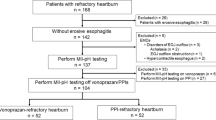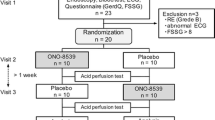Abstract
Background
Acid-sensing ion channels (ASICs) are esophageal nociceptors that are candidates to mediate heartburn in non-erosive reflux disease (NERD). Amiloride, a diuretic, is known to inhibit ASICs. For this reason, we sought a role for ASICs in mediating heartburn by determining whether amiloride could block heartburn in NERD induced by esophageal acid perfusion.
Methods
In a randomized double-blind crossover study, we perfused the esophagus with amiloride or (saline) placebo prior to eliciting acid-induced heartburn in patients with a history of proton pump inhibitor-responsive NERD. Those with NERD and positive modified Bernstein test were randomized to perfusion with amiloride, 1 mmol/l, or placebo for 5 min, followed by repeat acid-perfusion. Heartburn severity and time to onset was measured and the process repeated following crossover to the alternative agent.
Results
14 subjects completed the study. Amiloride did not reduce the frequency (100 vs. 100 %) or severity of acid-induced heartburn (Mean 2.50 ± SEM 0.33 vs. 2.64 ± 0.45), respectively. There was a trend towards longer time to onset of heartburn for amiloride versus placebo (Mean 2.93 ± SEM 0.3 vs. 2.36 ± 0.29 min, respectively), though these differences did not reach statistical significance (p > 0.05).
Conclusions
Amiloride had no significant effect on acid-induced heartburn frequency or severity in NERD, although there was a trend towards prolonged time to onset of symptoms.



Similar content being viewed by others
References
Bhat YM, Bielefeldt K. Capsaicin receptor (TRPV1) and non-erosive reflux disease. Eur J Gastroenterol Hepatol. 2006;18:263–270.
Akiba Y, Mizumori M, Kuo M, et al. CO2 chemo sensing in rat oesophagus. Gut. 2008;57:1654–1664.
Matthews PJ, Aziz Q, Facer P, Davis JB, Thompson DG, Anand P. Increased capsaicin receptor TRPV1 nerve fibres in the inflamed human oesophagus. Eur J Gastroenterol Hepatol. 2004;16:897–902.
Page AJ, Brierley SM, Martin CM, et al. Different contributions of ASIC channels 1a, 2, 3 in gastrointestinal mechanosensory function. Gut. 2005;54:1408–1415.
Leffler A, Monter B, Koltzenburg M. The role of the capsaicin receptor TRPV1 and acid-sensing ion channels (ASICs) in proton sensitivity of subpopulations of primary nociceptive neurons in rats and mice. Neuroscience. 2006;139:699–709.
Kindt S, Vos R, Blondeau K, Tack J. Influence of intra-oesophageal capsaicin instillation on heartburn induction and oesophageal sensitivity in man. Neurogastroenterol Motil. 2009;21:1032–e82.
Krarup AL, Ny L, Astrand M, et al. Randomised clinical trial: the efficacy of a transient receptor potential vanilloid 1 antagonist AZD1386 in human oesophageal pain. Aliment Pharmacol Ther. 2011;33:1113–1122.
Ugawa S, Ueda T, Ishida Y, Nishigaki M, Shibata Y, Shimada S. Amiloride-blockable acid-sensing ion channels are leading acid sensors expressed in human nociceptors. J Clin Invest. 2002;110:1185–1190.
Nuzum CT. Nasogastric intubation. In: Drossman DA, ed. Manual of Gastroenterologic Procedures. New York: Raven Press; 1982:11–15.
Tobey NA, Carson JL, Alkiek RA, Orlando RC. Dilated intercellular spaces: a morphological feature of acid reflux-damaged human esophageal epithelium. Gastroenterology. 1996;111:1200–1205.
Tobey NA, Hosseini SS, Argote CM, Dobrucali AM, Awayda MS, Orlando RC. Dilated intercellular spaces and shunt permeability in nonerosive acid-damaged esophageal epithelium. Am J Gastroenterol. 2004;99:13–22.
Barlow WJ, Orlando RC. The pathogenesis of heartburn in nonerosive reflux disease: a unifying hypothesis. Gastroenterology. 2005;128:771–778.
Calabrese C, Bortolotti M, Fabbri A, et al. Reversibility of GERD ultrastructural alterations and relief of symptoms after omeprazole treatment. Am J Gastroenterol. 2005;100:537–542.
Kern M, Hofmann C, Hyde J, Shaker R. Characterization of the cerebral cortical representation of heartburn in GERD patients. Am J Physiol Gastrointest Liver Physiol. 2004;286:G174–G181.
Jones NG, Slater R, Cadiou H, McNaughton P, McMahon SB. Acid-induced pain and its modulation in humans. J Neurosci. 2004;24:10974–10979.
Awayda MS, Bengrine A, Tobey NA, Stockand JD, Orlando RC. Nonselective cation transport in native esophageal epithelia. Am J Physiol Cell Physiol. 2004;287:C395–C402.
Acknowledgments
This research was conducted with financial support from the Investigator Sponsored Study Program of AstraZeneca. Dr. Hansen of Astra Zeneca provided expertise in the design of the trial, interpretation of the findings and in the development of this manuscript.
Conflict of interest
None.
Author information
Authors and Affiliations
Corresponding author
Rights and permissions
About this article
Cite this article
Bulsiewicz, W.J., Shaheen, N.J., Hansen, M.B. et al. Effect of Amiloride on Experimental Acid-Induced Heartburn in Non-erosive Reflux Disease. Dig Dis Sci 58, 1955–1959 (2013). https://doi.org/10.1007/s10620-013-2586-0
Received:
Accepted:
Published:
Issue Date:
DOI: https://doi.org/10.1007/s10620-013-2586-0




